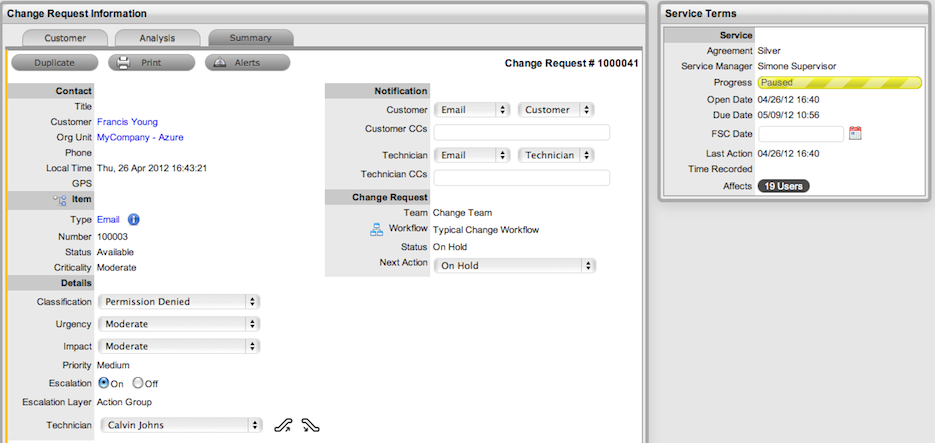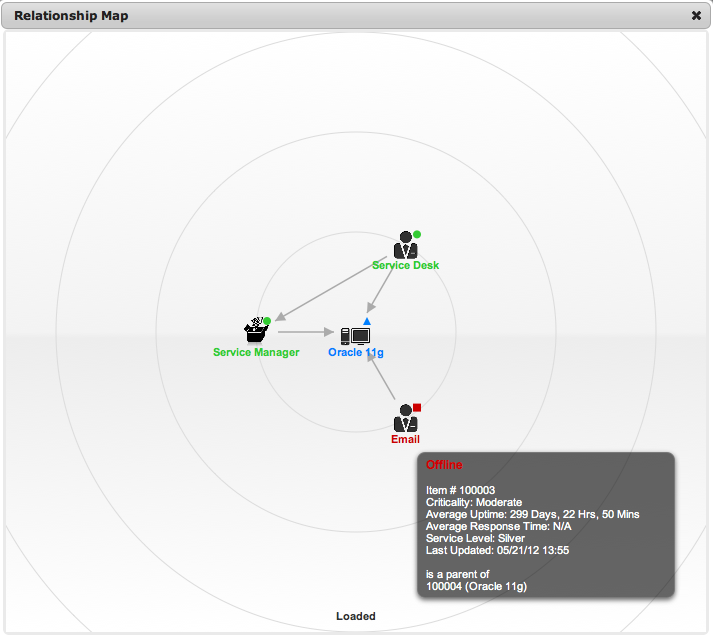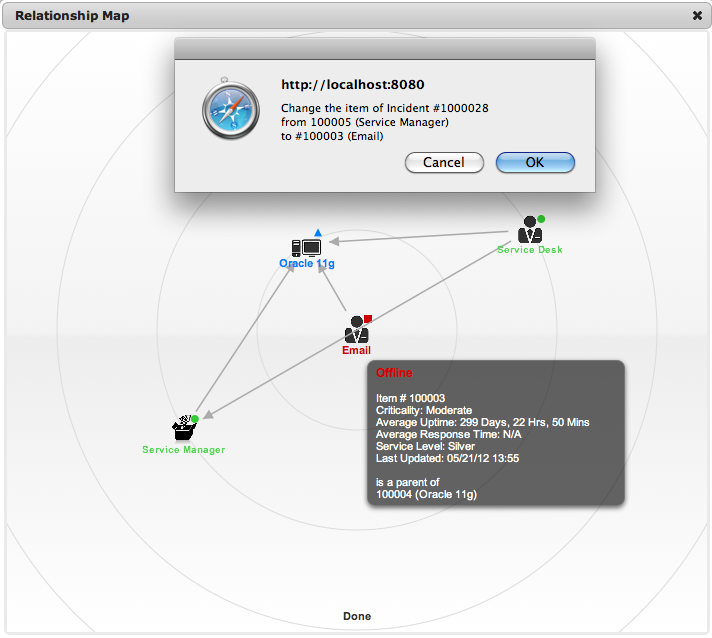The Summary tab provides comprehensive details related to an RFC and
gives access to the tabs required to work on the RFC. To view the details
of a Customer select the Customer name link within the Request Information
screen. The Customer and Item assigned to the Request can be updated within
the Customer tab by selecting ![]() ,
when in Edit mode.
,
when in Edit mode.
The Change Request Information Summary tab includes the following:
Summary Tab |
Description |
|---|---|
Contact |
Displays the Customer assigned to the RFC and their contact information. Click on the Customer Name or Org.Unit link for more details relating to Customer and Org Unit.
To update the Customer details assigned to the request, click on the Customer tab and ensure the Request is in edit mode. |
Item |
Displays the Item assigned
to the RFC. Scroll over
Click
|
Details |
|
Classification |
Displays the RFC Classification that was selected when the Change Request was created. This can be updated, if required. |
Priority |
Shows the Priority of the RFC, which determines the Service Level triggers applied to the Request. If the Derived option is enabled in the applications Setup, then the Urgency and Impact drop-down lists are displayed. The User is required to select the corresponding Urgency and Impact for the Change Request to alter the Priority assigned. See Priority. |
Escalation |
This is visible if the Escalation Control option is enabled in the application Setup. This is only available to the Supervisor, and allows them to disable the escalation timers. See Escalation. |
Escalation Layer |
Shows the name of the current Group of Users assigned to the Request. When the Workflow State is updated, this could also result in an update of the assigned Group of Users. |
Technician |
The name of the Technician assigned to the RFC. |
Notification |
|
Customer |
Shows how updates regarding the RFC are sent to the Customer who logged the RFC, or to all Owners of the Item associated with the RFC. Customer CCs is a free text field for any additional notification recipients, these can be divided into Customer and Technician CC lists. See Notification. |
Technician |
Allows the User to adjust the default Technician notification between None, Email or SMS for updating the assigned Technician, all Technicians in the Team or Layer of Escalation assigned to the RFC.
Technician CCs is a free text field for any additional notification recipients, these can be divided into Customer and Technician CC lists. See Notification. |
Alternate Team |
Is visible if the Notify Alternate Team option is enabled in the Admin>Email>Setup tab. This allows the User to define another Team to be notified about updates regarding the RFC. |
Change Request |
|
Team |
Displays the default support Team assigned to the RFC. This can be changed by selecting another option within the drop-down list. The Team list is derived from the Workflow and Workflow State. |
Workflow |
Displays the default Workflow assigned to the RFC. This can be changed by selecting another option within the drop-down list. The Workflow list is derived from the SLA assigned to the RFC. Select |
Status |
Shows the current Workflow State of the RFC. See Status. |
Next Action |
Lists all the states available
after the current RFC State. This is based on the Workflow assigned
to the RFC. To move the RFC through the Workflow, select a Status
included in the list displayed. |
Status Due |
Details the expiry time for the current Workflow State if the State has an OLA assigned. |
Service Terms |
|
Agreement |
Displays the Service Level Agreement assigned to the RFC. The service level is derived from either the Item, Customer or Organizational Unit. |
Service Manager |
Displays the name of the Service Level Manager responsible for overseeing Requests related to the assigned service agreement. |
Progress |
Visually displays how the RFC is tracking against the assigned SLA and displays the percentage of SLA used when greater than 10%. The grey progress bar is gradually filled in based on the status:
|
Dates |
Summarizes the important date details for the RFC. The Due Date is automatically calculated based on the Service Level assigned to the RFC. See: Request Details. |
Time Recorded |
Displays the amount of time the Request has been open and worked on. See: Time Recorded. |
Affects |
Displays the number of Users assigned to the Item. |

Only Technicians assigned to the Workflow Group associated with the RFC can edit the Change Request.
For each RFC additional details and options are available within the Summary tab. These allow Users to add Notes, analyze the Change Request and view its history. The options include:
Summary Tab Buttons |
|
|
Edit opens the Request in edit mode. This allows the Request details to be amended, Notes to be added and time is automatically recorded against the Request whilst in edit mode. |
|
Opens the Request in edit mode and moves directly to the New Note editor. See: New Note |
|
Duplicate creates a copy of the Request and links the copy to the original Request. The User can then amend the Customer or Item details, if required. |
|
Print opens a summary of the Request in a Print View window. This includes a Description and all Notes added to the Request. It is a good alternative for viewing Request information within one window when adding a new Note. |
|
Allows the User to create or view reminders related to the RFC. When published it will be displayed like the normal alert icon. |
|
This option is visible next to the Item Type, if the RFC is in a Workflow State with the Item Editable option is set to Yes. Click the icon to edit the Item details. |
|
The escalation buttons allow the User to escalate the Request to the next layer within the Team, or de-escalate the Request to the lower level, if required. |
After an RFC is created, it may be necessary to change the assigned Customer or Item. This may be the case when the Unknown Item is associated with a RFC, or a Service Item has been assigned to the RFC and the relevant hardware, software or network Item needs to be associated with the request. When the "Allow Unknown" option is disabled in the Setup>Privileges>Requests tab and a Request that is assigned to the Unknown Item is opened in Edit mode, the User will be prompted to update the Item assigned to the RFC before the Save button action can successfully record changes to the RFC.
This option is also required when a request is created through email, as the Item assigned may be the system's default Unknown Item or the Org Unit's default Item.
To change the Item:
Click the RFC's Edit button
Select the RFC's Customer tab
Click the Item
Number ![]()
The Find Item option appears.
Search and select a new Item
Click Apply to update the RFC
Select the Summary tab to continue working on the RFC, or click Cancel and Done to close the RFC with the newly assigned Item.
To change the Customer:
Click the RFC's Edit button
Select the RFC's Customer tab
Click ![]() next to the Customer Name
next to the Customer Name
Search and select a Customer
Click ![]()
If the RFC's Item needs to be altered as a result of the Customer change
the Find Item field appears. Search and select the appropriate Item
using the Find Item search.
Select the Summary tab, to continue working on the RFC
Click Save.
Technicians do not have the ability to delete Change Requests or Customers.
Selecting ![]() opens a pop-up window that displays a map of Items that are related to
the Request Item that can be navigated by clicking on the icons within
the map. To view related Item information, scroll over the relevant Item
icon.
opens a pop-up window that displays a map of Items that are related to
the Request Item that can be navigated by clicking on the icons within
the map. To view related Item information, scroll over the relevant Item
icon.

The Item associated with the Request can be updated when in the request is in Edit mode:
Select ![]()
Navigate the map to move the relevant Item
icon to the central point of the map
Select the Item icon label in the Map to move it to the central node.
Click the icon label when it is in the middle
of the map
A warning message is displayed, prompting the confirmation of the Item
change.

Select OK and the Item association will be
updated
(If the Enable Item Shadow option is enabled by the Administrator in
the Setup>Privileges>Customer tab, the change of Item information
will not be visible on the Customer Portal.)
Select ![]() to close the window.
to close the window.
The Item assignment change is recorded in the Audit tab.
See: Item Relationships